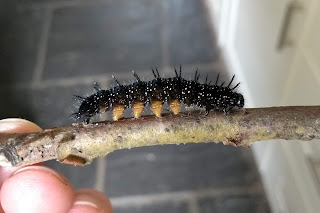 |
| Day 1 (With us) |
On the 18th of July I was out on one of our daily dog walks out in West Cowal on Argyll's Secret Coast, a peninsula on the west coast of Scotland. As I walked past some long grass and weeds. I spotted something that "didn't belong there", something that looked out of place. I was a good 3-4 metres away, I thought I was probably imagining things but you never know if you don't explore further. I thought, if I was lucky, it might be a butterfly or moth hiding in the long grass. As I got closer I soon realised it was a small group of caterpillars on a cluster of nettles. These black, spikey caterpillars are those of the colourful Peacock butterfly. I remember seeing them as a kid, but then in their hundreds, safe in the web they form around themselves as protection from predators. They are one of many breeds of butterfly and moth that feed from nettles as larvae. One of the reasons it's so important to not get rid of all nettles in your garden. They also tend to be one of the earliest plants to flower after winter which many animals rely on when nectar is scarce.
 |
| Day 2 |
We were due to move house a week later but I couldn't resist bringing two home to rear. We'd enjoyed looking after our Large Whites so much during winter so I knew I'd be a fool to not have another chance to see the magic transformation these guys would go through. Peacocks are incredibly easy to rear as well as nettles are generally an easy food to find fresh for them (it also keeps it's freshness well over several days). They also grow fairly fast as caterpillars (the ones I had were already in their 5th and last instar), and only spend about two weeks in their cocoons meaning you won't have a long wait.
 |
| Day 4 |
Along with nettles in their tub I made sure to keep a few sticks so they could pupate on them when ready. The tub needs to be cleaned out and ensure ventilation to avoid mold. By the 23rd they'd made green pupaes.
 |
| Day 6 |
As you can see the chrysalis darkened as the days went by, the photo below is from the 27th of July.
 |
| Day 10 |
This morning, the 4th of August, I checked on the pupae and noted they'd turned black in colour. I anticipated that meant they'd be ready to emerge very soon as I've had both Large Whites and Painted Ladies at home before.
 |
| Day 18 |
At about 16:00 this afternoon I was in the kitchen and felt a sudden urge to check on the two pupae. I'm glad I did, both had emerged but one was lying flapping on its back. As I helped it back onto the stick I realised something that hadn't dawned on me before. That they must rely on hanging upsidedown to help their wings expand and stretch out properly. I seem to have rescued this one in time even if it's got slight bends to its wings it shouldn't have I think it might be alright. However it explains why one of our Whites earlier this year had badly developed wings. I've also seen a Ringlet in the wild that had very unfolded wings.
Incredible that those little, spikey caterpillars that I collected just a few weeks ago have undergone this amazing transformation and emerged as the magical being below. They've done it while we packed, moved and unpacked our home (for the second time in 3 months) - even though I feel like their metamorphosis is more impressive I can also see how our journeys are similar. We've emerged at the end of this with a very homely home. I hope these two Peacocks enjoy flying free in Perthshire as much as we do.
Edit: earlier I used the word "cocoon" instead of "pupa" and learnt this: Strictly speaking, a cocoon is a silk covering of the pupa. Butterflies therefore do not make cocoons, although many moths do.




Comments
Post a Comment